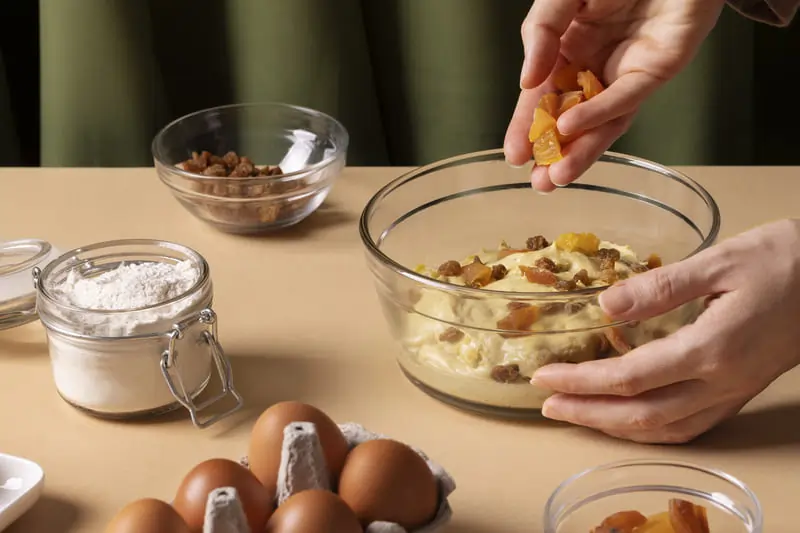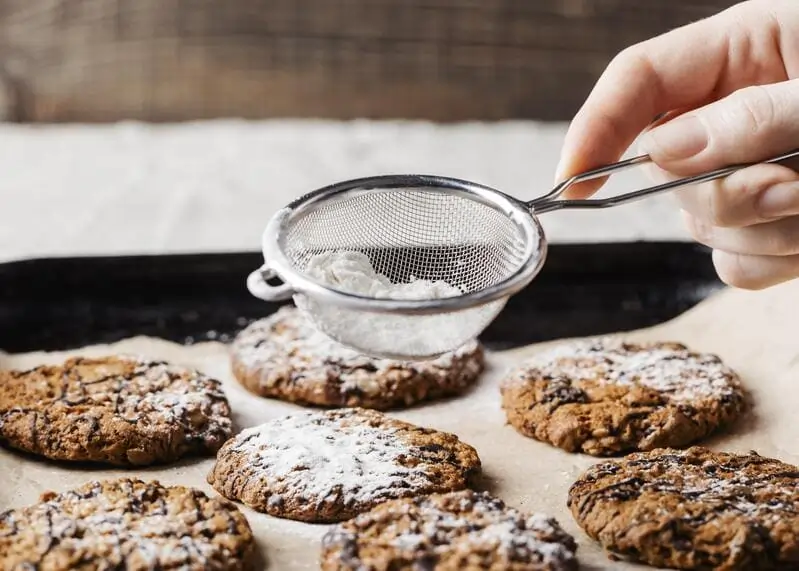Soft, chewy cookies hold a special place in the hearts of baking enthusiasts and dessert lovers alike. But achieving that melt-in-your-mouth texture can sometimes feel like a mystery. So, what is the secret ingredient to keep cookies soft? This guide unravels the baking secrets to help you achieve consistently soft and delectable cookies.
The Science of Cookie Texture
The softness of cookies depends on a careful balance of ingredients and techniques. Each element in the recipe plays a crucial role:
- Fat: Butter adds flavor and softness, while alternatives like shortening can create a chewier texture.
- Sugar: Using brown sugar retains more moisture than white sugar due to its molasses content.
- Flour and Starch: Adding cornstarch or cake flour contributes to a tender crumb.
Baking time and temperature are equally important. A lower oven temperature combined with slightly underbaking your cookies ensures they stay soft long after cooling. Learn more about the science behind baking cookies to perfect your technique.
For additional dessert inspiration, you can explore simple and delicious banana bread recipes, which emphasize balancing moisture and texture.
The Secret Ingredient: What Keeps Cookies Soft?
Creating irresistibly soft cookies is every baker’s goal, and achieving that perfect texture is not about a single “magic” ingredient but a combination of thoughtful choices. Ingredients like brown sugar, cornstarch, and liquid sweeteners work together to lock in moisture and maintain a tender, chewy consistency. Understanding how these components interact can elevate your baking game. For more tips and tricks, visit our guide to baking tips for perfect cookies, and discover how to enhance your creations with colorful ingredients in cookie recipes.
Ingredients That Keep Cookies Soft
1. Brown Sugar: Locks in Moisture
- Why It Works: Brown sugar contains molasses, a natural humectant that retains moisture in the dough, preventing cookies from drying out.
- How to Use:
- Replace some or all of the granulated sugar in your recipe with brown sugar for a softer, chewier texture.
- For extra chewiness, dark brown sugar, which has a higher molasses content, works particularly well.
- Pro Tip: Combine brown sugar with a splash of vanilla extract for an added depth of flavor and aroma.
While brown sugar adds softness, incorporating cornstarch takes the texture to the next level.
2. Cornstarch: Adds Tenderness
- Why It Works: Cornstarch is a key ingredient in achieving a delicate, cake-like texture in cookies. It prevents the formation of too much gluten, resulting in a soft, tender crumb.
- How to Use:
- Add 1–2 teaspoons of cornstarch to your dry ingredients. This small amount has a noticeable impact on the cookie’s texture.
- For ultra-soft cookies, use cornstarch in combination with brown sugar.
- Pro Tip: Cornstarch is especially effective in sugar cookies or peanut butter cookies, giving them a melt-in-your-mouth quality.
While cornstarch creates tenderness, liquid sweeteners like honey or corn syrup bring moisture and chewiness to the table.
3. Honey or Corn Syrup: Boosts Moisture
- Why It Works: Honey and corn syrup are liquid sweeteners that trap moisture in the dough, resulting in a chewy finish.
- How to Use:
- Replace 1–2 tablespoons of sugar with honey or corn syrup. This substitution enhances moisture without significantly altering the sweetness level.
- Pair with other softening agents, such as brown sugar and cornstarch, for optimal results.
- Pro Tip: If you’re using honey, opt for a mild-flavored variety like clover honey to avoid overpowering the cookie’s taste.
Combining these ingredients strategically can create cookies that are soft, tender, and perfectly chewy. But there are more techniques to keep your cookies irresistibly moist.
Additional Tips for Soft Cookies
- Use Butter at Room Temperature:
- Properly softened butter blends more evenly with sugar, creating a smoother dough and softer texture.
- For extra softness, consider replacing part of the butter with cream cheese.
- Do Not Overbake:
- Soft cookies are often slightly underbaked. Remove them from the oven when the edges are set, but the centers appear slightly underdone—they’ll continue to firm up as they cool.
- Chill the Dough:
- Refrigerating the dough for 30 minutes to an hour prevents cookies from spreading too much during baking, keeping them thick and soft.
Pro Tip: Store cookies in an airtight container with a slice of bread or an apple wedge to maintain their softness longer.
With these techniques in mind, you’re ready to explore more creative ways to enhance your cookie recipes.
Make Your Cookies More Appealing
While mastering the art of soft cookies, don’t forget to explore creative elements like colorful ingredients or unique decorations:
- Colorful Additions: Try incorporating vibrant sprinkles, candy-coated chocolates, or naturally colored frostings to add visual appeal. Learn more in our guide to colorful ingredients in cookie recipes.
- Flavor Enhancements: Experiment with extracts like almond or maple, or add spices like cinnamon and cardamom for a warm, aromatic twist.
Perfecting Soft Cookies
Achieving soft cookies is a delicate balance of selecting the right ingredients and applying smart techniques. By using brown sugar, cornstarch, and liquid sweeteners, you can consistently bake cookies that are moist, tender, and utterly satisfying. For even more inspiration, check out our baking tips for perfect cookies and start experimenting with new flavors and textures today!
Tips to Maintain Cookie Softness

Baking soft cookies is one thing, but keeping them soft and fresh is another challenge. Luckily, a few smart techniques can ensure your cookies stay tender and moist long after they come out of the oven. Whether it’s chilling the dough, mastering the art of underbaking, or using proper storage methods, these tips will help you maintain the perfect cookie texture. For additional inspiration on improving your baking techniques, explore our baking tips for perfect cookies.
1. Refrigerate the Dough
Refrigerating cookie dough is a game-changer for achieving softer cookies and better flavor.
- Why It Works:
- Chilling the dough for at least 30 minutes helps solidify the fat in the recipe, which slows spreading during baking. This creates thicker cookies with soft, chewy centers.
- During refrigeration, the flavors in the dough have time to develop and deepen, resulting in richer-tasting cookies.
- How to Do It:
- Place your cookie dough in an airtight container or wrap it tightly in plastic wrap before refrigerating.
- If chilling for more than an hour, let the dough sit at room temperature for a few minutes to soften slightly before shaping.
Pro Tip: For even softer cookies, refrigerate the dough overnight. The extended chill time enhances the flavor and improves the texture.
While chilling the dough helps set the stage for soft cookies, perfect timing during baking is equally important.
2. Underbake Slightly
One of the secrets to maintaining cookie softness is mastering the art of underbaking.
- Why It Works:
- Removing cookies from the oven when the edges are just set but the centers are still soft ensures they don’t overbake.
- The residual heat from the baking sheet continues cooking the cookies as they cool, achieving the ideal consistency.
- How to Do It:
- Bake your cookies 1–2 minutes less than the full recommended time. Keep a close eye on them during the last few minutes to avoid overcooking.
- Look for slightly golden edges while the centers remain slightly puffed and underdone.
Pro Tip: Let the cookies cool on the baking sheet for 3–5 minutes before transferring them to a wire rack. This allows them to firm up slightly while staying moist and soft.
Even perfectly baked cookies can lose their softness if not stored properly. That’s where smart storage techniques come into play.
3. Proper Storage Techniques
Storing cookies correctly is essential to maintaining their texture and flavor.
- Use an Airtight Container:
- Store cookies in an airtight container to prevent air exposure, which can cause them to dry out.
- If stacking cookies, place parchment paper between layers to avoid sticking.
- Add a Slice of Bread:
- Place a slice of bread in the container with the cookies. The bread absorbs any moisture loss, keeping the cookies soft for several days.
- Replace the bread slice if it becomes dry.
- Freeze for Longer Storage:
- For long-term storage, freeze baked cookies in a freezer-safe bag or container. Thaw at room temperature when ready to enjoy, and they’ll still retain their softness.
Pro Tip: For extra freshness, consider individually wrapping cookies in plastic wrap before placing them in the container.
With these tips, you can keep your cookies soft and delicious for days, but there are additional techniques to ensure they stay bakery-fresh.
Bonus Tips for Extra Softness
- Use Brown Sugar: Its molasses content helps retain moisture, resulting in softer cookies. Learn more about ingredient tweaks in our guide to what keeps cookies soft.
- Avoid Overmixing the Dough: Overmixing develops too much gluten, which can lead to tougher cookies. Mix just until the ingredients are combined.
- Add a Touch of Honey or Corn Syrup: These liquid sweeteners help lock in moisture, ensuring a chewy texture.
Keep Your Cookies Bakery-Fresh
By following these practical tips—chilling the dough, underbaking slightly, and using smart storage techniques—you can enjoy soft, fresh cookies for days after baking. For more creative ways to enhance your baking skills, visit our cookie decorating guide or explore colorful ingredients for cookie recipes to add flair to your treats!
Avoiding Common Baking Mistakes

Even the most experienced bakers encounter challenges in the kitchen. Certain mistakes can affect the texture, flavor, or appearance of cookies. By understanding these common pitfalls and how to avoid them, you can elevate your baking and consistently produce perfect cookies. For additional tips, check out our baking tips for perfect cookies and learn how to troubleshoot baking issues effectively.
1. Overmixing the Dough
Why It’s a Problem:
Overmixing cookie dough can lead to the development of too much gluten, resulting in cookies that are dense, tough, and chewy in an undesirable way.
How to Avoid It:
- Mix the dough until the ingredients are just combined. Once the flour is incorporated, stop mixing to prevent excess gluten formation.
- Use a spatula or wooden spoon for better control, especially if you’re prone to overmixing with a stand or hand mixer.
Pro Tip: If your recipe calls for add-ins like chocolate chips or nuts, fold them in by hand to avoid further mixing the dough.
While mixing correctly ensures the right texture, using fresh ingredients is key to achieving optimal results.
2. Using Expired Ingredients
Why It’s a Problem:
Old baking soda, baking powder, or stale ingredients can affect the leavening process and flavor, resulting in flat, dense, or bland cookies.
How to Avoid It:
- Check Expiration Dates: Regularly inspect your pantry staples like baking soda, baking powder, and flour. Replace any expired items.
- Test Baking Soda or Powder:
- To test baking powder, mix 1 teaspoon with 1/4 cup of hot water. It should bubble vigorously if it’s still active.
- For baking soda, mix 1 teaspoon with 1 tablespoon of vinegar or lemon juice. Look for immediate fizzing.
Pro Tip: Store ingredients in airtight containers in a cool, dry place to extend their shelf life.
Once you’ve ensured your ingredients are fresh, proper handling during and after baking is equally important to avoid overcooking.
3. Skipping Cooling Racks
Why It’s a Problem:
Leaving cookies on a hot baking sheet after removing them from the oven can lead to overcooking. The residual heat continues to bake the cookies, which can dry them out or make them overly crisp.
How to Avoid It:
- Transfer Promptly: After removing cookies from the oven, let them sit on the baking sheet for just 2–3 minutes to firm up slightly. Then transfer them to a cooling rack.
- Use a Cooling Rack: Cooling racks allow air to circulate around the cookies, preventing sogginess and ensuring an even finish.
Pro Tip: If you don’t have a cooling rack, use a plate lined with parchment paper or a clean kitchen towel as a temporary solution.
Along with these key tips, there are additional steps you can take to ensure flawless cookies every time.
Bonus Tips for Avoiding Baking Mistakes
- Measure Ingredients Correctly: Inaccurate measurements can alter the texture and taste of your cookies. Use a kitchen scale for precision or the scoop-and-level method for dry ingredients.
- Preheat Your Oven: Baking in an oven that hasn’t fully preheated can lead to unevenly baked cookies. Use an oven thermometer to ensure the temperature is accurate.
- Avoid Overcrowding the Baking Sheet: Spacing cookies too closely can cause them to spread into each other, resulting in uneven shapes and textures. Leave at least 2 inches of space between cookies.
Pro Tip: Experiment with chilling your dough to improve flavor and prevent spreading. Learn more in our guide to maintaining cookie softness.
Perfecting Your Baking Game
Avoiding these common baking mistakes can make a world of difference in your cookie results. By mixing carefully, using fresh ingredients, and transferring cookies to a cooling rack promptly, you’ll ensure your treats are consistently soft, flavorful, and perfectly baked. For more inspiration, explore our baking tips for perfect cookies or dive into creative cookie variations to take your baking to the next level!
Advanced Techniques for Softer Cookies
Once you’ve mastered the basics of baking soft cookies, it’s time to explore advanced techniques that can take your treats to the next level. From adding unique ingredients to incorporating acidity for improved texture, these methods will help you create cookies that are irresistibly tender and flavorful. For more creative ideas, explore our baking tips for perfect cookies and learn how to customize your recipes with flair.
1. Add Pudding Mix
Why It Works:
Instant pudding mix is a game-changer for cookie texture. It contains starches and sugars that enhance moisture retention, resulting in cookies that stay soft and chewy for longer. Bonus: it also adds extra flavor.
How to Use It:
- Add one small box (3.4 ounces) of instant pudding mix to your dry ingredients.
- Choose a flavor that complements your cookie, such as vanilla for classic cookies, chocolate for rich treats, or butterscotch for a unique twist.
Pro Tip: If you’re adding pudding mix, slightly reduce the sugar in your recipe to avoid overly sweet cookies.
While pudding mix introduces softness and flavor, incorporating acidic ingredients can work wonders for the dough’s structure.
2. Incorporate Acidic Ingredients
Why It Works:
Acidic ingredients, like vinegar or lemon juice, help break down gluten strands in the dough, making the cookies more tender. They also enhance flavor balance by cutting through sweetness.
How to Use Them:
- Add 1 teaspoon of vinegar or lemon juice to your wet ingredients. It won’t alter the flavor significantly but will create a softer texture.
- For recipes that already include an acidic component, like brown sugar (which contains molasses), the additional acidity complements the leavening agents like baking soda for better lift.
Pro Tip: Apple cider vinegar is a great choice for cookies as it’s mild and adds subtle depth to the flavor profile.
In addition to these techniques, tweaking the fat content can further elevate the softness of your cookies.
Bonus Advanced Tips for Softer Cookies
- Experiment with Different Fats:
- Replace part of the butter with cream cheese or shortening for an ultra-soft texture.
- Use melted butter for denser, chewier cookies.
- Use Bread Flour:
- Substituting part of the all-purpose flour with bread flour (which has a higher protein content) creates a chewier texture while maintaining softness.
- Chill the Dough Longer:
- Chilling dough overnight allows the flour to fully hydrate and the flavors to develop, resulting in softer, more flavorful cookies.
Pro Tip: Pair these advanced techniques with creative variations, such as adding colorful ingredients or unique fillings. Check out our guide to colorful cookie ingredients for more ideas.
The Science Behind Softer Cookies
Each of these techniques enhances softness in its own way. Pudding mix retains moisture, acidic ingredients break down gluten, and fat or flour adjustments create the perfect balance of tenderness and chewiness. By combining these methods, you’ll master the art of crafting bakery-quality cookies at home. For further exploration, don’t miss our baking tips for perfect cookies and take your cookie baking to new heights!
FAQs
Here are answers to some commonly asked questions about soft cookies:
Why do cookies turn hard?
Exposure to air and overbaking are common culprits. Proper storage is key. For more tips, read about how to store cookies properly.
Can I use oil instead of butter?
Yes, but butter adds a richer flavor. Use oil for a slightly denser, softer texture. Learn more about creative ingredient swaps for baking.
What is the best sugar to use for soft cookies?
Brown sugar is ideal for softness due to its higher moisture content. Explore additional techniques for moist and flavorful cookie recipes.
Is refrigerating cookie dough necessary?
It’s not mandatory but highly recommended for thicker, softer cookies. Learn the benefits of preparing dough ahead of time.
How do professional bakers keep cookies soft?
They use high-moisture ingredients like brown sugar and employ proper storage techniques. Discover additional insights on retaining cookie softness.
These internal links enhance user navigation while improving the SEO of your post. Let me know if further refinements are needed!
Conclusion
Keeping cookies soft isn’t just about one secret ingredient—it’s about combining the right techniques, using moisture-retaining ingredients, and storing them properly. By incorporating brown sugar, cornstarch, and a touch of honey or syrup, you can ensure every batch turns out soft and delicious.
To learn more about achieving the ideal cookie texture, read about vibrant and creative cookie designs.

